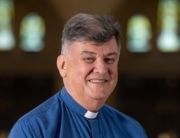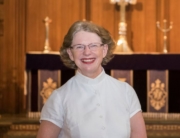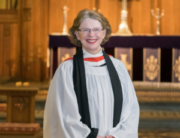The Very Rev’d Frank Nelson
2 Samuel 23: 1 – 7
Psalm 132: 1 – 12
Revelation 1: 4b – 8
John 18: 33 – 37
Christ the King! As you will have seen from the Welcome notes on the front page of today’s service sheet, the Feast of Christ the King is a newcomer to the Christian calendar. In many ways it is an unnecessary festival – we already have one in Ascension Day. Yet here we are, on the last Sunday of the Christian liturgical year, celebrating Christ the King. Immediately before you, as the central figure of the beautiful reredos towering above the high altar is the image of Christ in glory. By contrast, and equally valid in Christian thinking, in the window to your left, is another portrayal of Christ the king as the suffering Christ. No splendid robes and golden crown there – but a naked broken crown-of-thorns wearing body of a dead man.
Interestingly, both the Feast of Christ the King, and the installation of the window to your left with the suffering Christ, came about in the aftermath of the First World War. The window as a memorial to the terrible loss of life during that war, and the festival in response to the growing sense of nationalism which so concerned Pope Pius XI. The reredos with its figure of Christ in glory reflects the thinking of a generation earlier – when it seemed, at least if you were English speaking, that Britannia did indeed rule the waves, and the British Empire would last forever.
These two contrasting images of Christ the king can be taken into consideration as we read today’s Gospel – a few verses from the confrontation between Pontius Pilate, representative of one of the most powerful and ruthless empires ever, and Jesus of Nazareth, who stands before him, betrayed by a friend, deserted by his closest allies – alone and utterly vulnerable and without power. Or so it seems.
It’s a well-known Gospel scene – this snippet from the trial of Jesus on the first Good Friday. The Roman Governor, Pontius Pilate, with all the might of the Roman legions standing behind him, is perplexed and puzzled by this miserable man, accused by his own people, the religious leaders, the chief priests. Come with me on a short exploration of power as we look briefly at the three characters – Pilate, Jesus and the chief priests.
Pilate is the figure of authority – no doubt about that. He has the backing of the all-powerful Roman Empire behind him, he represents Caesar, Lord, in this troubled city of Jerusalem. Yet he is beholden to the pressure of the chief priests. They bring an accusation against Jesus, and seek the aid of Pilate, apparently and obsequiously recognising that his is the power in the land. I say apparently for it strikes one as odd that this powerful figure of Pilate is, in a sense, held ransom by the religious views of the chief priests. It is Pilate who must shuttle back and forth between the chief priests and Jesus: the chief priests, the accusers who refuse to enter Pilate’s headquarters, and who, in effect, bully Pilate into giving them what they want, and the accused – Jesus, who stands there alone, defenceless, yet unbowed and uncowed.
In the gospel-writer’s eyes, Pontius Pilate is portrayed as a weak man, unable to stand up against the chief priests, and utterly confused by his question and answer session with Jesus. In the end he yields to pressure from the chief priests and the rabble and their blood-thirsty baying for Jesus’s blood. “Away with him! Away with him! Crucify him!” (John 19: 15) How many of today’s leaders, newly elected to power and thinking they will be able to implement their policies, discover they are trapped between their own noble convictions of making the world a better place, and the stubborn power of the crowd, the inertia of a caucus room, a hostile opposition? Pilate does in fact have one final crack at regaining some power. When the chief priests ask him to change the inscription above the crucified Jesus’s head he refuses in words that have become immortalised: “What I have written, I have written.” (John 19: 22) In his shame, his agony, his dying, Jesus is identified for who he really is – “The King of the Jews”.
So what about this powerless vulnerable man who is caught between Pontius Pilate and the hatred of the chief priests? This Jesus of Nazareth? “My kingdom is not from this world” he says. Yet it could be argued that Jesus’s kingdom is absolutely in the world. This weak vulnerable man who is killed to satisfy the baying lust of the chief priests overturns all the power tables. Not only does he absorb the hatred, the evil, the death flung at him on the cross – but within a very short time there are people saying that he is not dead, he is alive. The story of Jesus did not, and does not, end on the cross. The cross is just the beginning.
The power of Jesus is exercised in such a radically different way that neither Pilate nor the chief priests could grasp it. It was the power of love – embedded in the Old Testament teaching of Torah, the Law of God, which stated that you shall love the Lord your God with all your heart, soul, mind and strength …. And you shall love your neighbour as yourself. In his own life and practice Jesus demonstrated that his understanding of neighbour went well beyond that of one’s friends, of like-minded people we get on with. Jesus stood rooted in Old Testament prophetic and kingly traditions that those with power had an obligation to care for the most vulnerable in society, the biblical widows and orphans, the lost, the last and the least.
Way back in the 4th century St Basil took this idea seriously when he founded a hospital for lepers, the most feared and shunned people in society. It was this hospital and Basil’s example that, centuries later, would inspire another man to care for lepers. His name was Gerard and his particular concern was for the crusading knights who contracted leprosy. It’s a long story that stretches through the centuries. The followers of Gerard, himself following the teachings and example of Jesus, were formed into a chivalrous order – the Order of St Lazarus of Jerusalem. Long before the arrival of the International Red Cross, the wearers of the eight-pointed green cross of the Order of St Lazarus were quietly getting on with caring for the lost, the last and the least – as they continue to do today.
As we celebrate the Feast of Christ the King today, as we receive the Body and Blood of Him who died on the cross, may we commit ourselves, again and again, to the service of those who are numbered among the lost, the last and the least – and all in the name of him who is the Alpha and Omega, the beginning and the end, the one who is, who was and who is to come.




